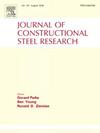冷弯不锈钢椭圆空心截面弯曲的数值研究
IF 4
2区 工程技术
Q1 CONSTRUCTION & BUILDING TECHNOLOGY
引用次数: 0
摘要
本文对纯弯曲冷成形不锈钢椭圆空心截面进行了数值研究。在本研究中,首次开发并验证了冷弯管梁的弯矩跨度和全跨度的数值模拟方法,其中对局部缺陷大小、塑性应变和残余应力进行了数值预测。基于验证的数值模型,对CFSS EHS梁进行了广泛的参数化研究;涵盖了小轴弯曲和大轴弯曲两种加载条件、侧向扭转屈曲效应、三种不锈钢合金、大范围的截面长径比和尺寸以及长细比值。利用生成的391个数值数据和收集到的试验数据,对现有设计规范ASCE/SEI 8-22、AS/NZS-4673和prEN 1993-1-4:2023 (E)规定的CFSS EHS梁设计方程和长细限值进行了评估。此外,还对AISI规定的用于CF方管和矩形管梁的直接强度法(DSM)和用于CFSS圆空心截面(CHS)梁的现有连续强度法(CSM)进行了评估。可以发现,上述设计方法对于CFSS EHS梁是保守的。本文对CFSS EHS梁提出了新的长细限值。对CFSS EHS梁的设计准则进行了适当的修改。本文章由计算机程序翻译,如有差异,请以英文原文为准。
Numerical investigation of cold-formed stainless steel elliptical hollow sections subjected to bending
The paper presents a numerical investigation on the cold formed stainless steel (CFSS) elliptical hollow section (EHS) subjected to pure bending. In this study, numerical modeling methodologies for cold-formed (CF) tubular beams with both the moment span and full span were first developed and validated, in which the local imperfection magnitude, plastic strains and residual stresses were predicted numerically. Based upon the validated numerical models, an extensive parametric study was carried out for CFSS EHS beams; covering two loading conditions of both the minor-axis bending and major-axis bending, the lateral-torsional buckling (LTB) effect, three stainless steel alloys, a large range of cross-section aspect ratios and sizes as well as slenderness values. A total of 391 generated numerical data together with the collected test data were used to assess the design equations and slenderness limits specified in the existing design codes of ASCE/SEI 8–22, AS/NZS-4673 and prEN 1993-1-4:2023 (E) for the design of CFSS EHS beams. In addition, the direct strength method (DSM) specified in AISI for CF square and rectangular tubular beams and the existing continuous strength method (CSM) for CFSS circular hollow section (CHS) beams were also assessed. It can be found that the aforementioned design methods were conservative for CFSS EHS beams. In this paper, new slenderness limits were proposed for CFSS EHS beams. Appropriate modifications on the design guidelines were also proposed for the CFSS EHS beams.
求助全文
通过发布文献求助,成功后即可免费获取论文全文。
去求助
来源期刊

Journal of Constructional Steel Research
工程技术-工程:土木
CiteScore
7.90
自引率
19.50%
发文量
550
审稿时长
46 days
期刊介绍:
The Journal of Constructional Steel Research provides an international forum for the presentation and discussion of the latest developments in structural steel research and their applications. It is aimed not only at researchers but also at those likely to be most affected by research results, i.e. designers and fabricators. Original papers of a high standard dealing with all aspects of steel research including theoretical and experimental research on elements, assemblages, connection and material properties are considered for publication.
 求助内容:
求助内容: 应助结果提醒方式:
应助结果提醒方式:


